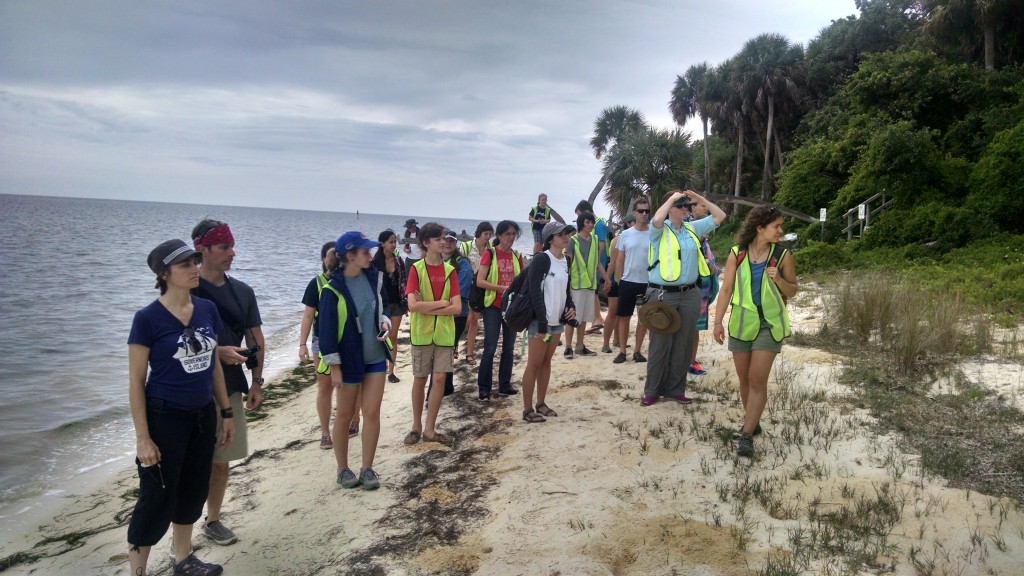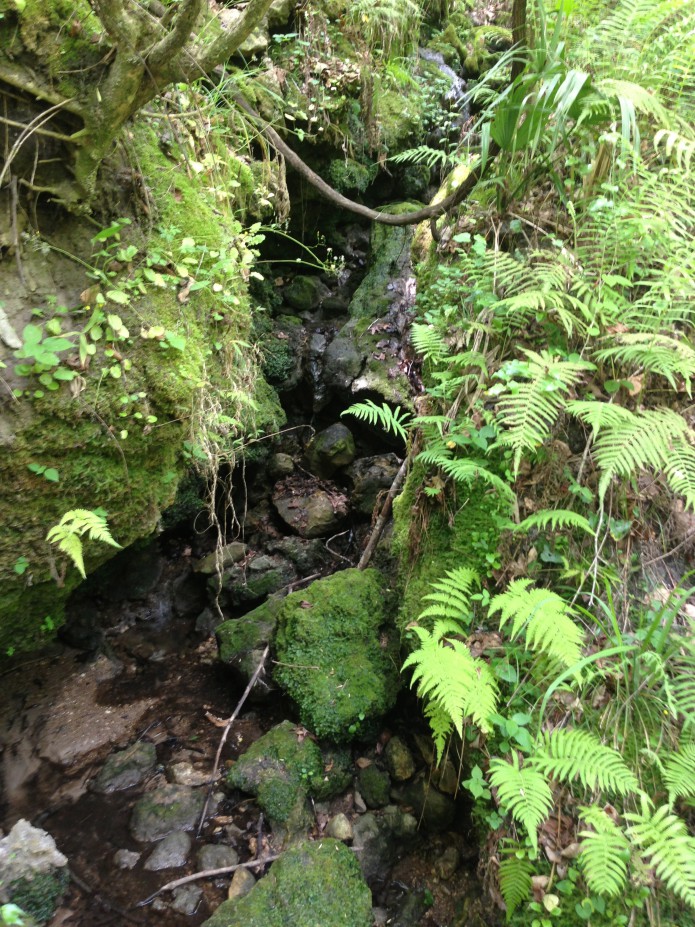Just off the Gulf coast fishing village of Cedar Key lies a group of uninhabited islands with white-sand beaches, coastal forests and creatures from ancient-looking horseshoe crabs to thousands of migratory birds. Shaped like its namesake, Seahorse Key is one of the largest bird rookeries in North Florida, and home to the University of Florida’s Seahorse Key National Marine Laboratory. UF is the only university in the nation with bi-coastal marine labs, Whitney in St. Augustine on the Atlantic side and Seahorse on the Gulf of Mexico, destination for this semester’s #EJUF field trip. Education and outreach coordinator Dr. Maria Sgambati led Environmental Journalism students on a memorable tour of the Seahorse beach, where we learned about coastal climate change impacts including tree die-offs and talked about how to cover this story in ways that can draw in new audiences. If you’re thinking about taking Environmental Journalism this fall, Seahorse Key is already on the syllabus!
Cynthia Barnett
Into the Devil’s Sink
By Stephenie Livingston
As the legend goes, the devil fell in love with a local Indian woman and opened up a hole in the earth to take her down with him to hell—giving birth to a sunken rain forest.
Called the Devil’s Millhopper for its shape, like that of a mill’s hopper, the sinkhole in northwest Gainesville has carved itself into the bowels of the Earth over the last 15,000 years. Once, millions of bones—fossils of early horses from younger layers of rock and sharks teeth from older layers when Florida was seafloor—covered the bottom of the ancient pit, before paleontologists and pilferers combed the area.
My descent down the 220 stairs into the devil’s bowels begins at noon. I pass a pignut hickory (Carya glabra), its bark marked by pronounced lines like engorged veins. I lift my sunglasses to get a closer look. The myth comes to my mind. People say they hear her screams at night. A shiver runs down my neck and I hear a possum move in the palmettos. The leaf of a bluff oak falls in my path. I pick it up. It crumbles in my hand.
Mosses and liverworts grow on the coquina rock that walls the cavity. Rain and spring waters, flowing along the limestone layers for millennia, have softened the rock wall. Stiff dogwood and red mulberry grow at precarious 45 degree angles around me. A force pulls the trees downward, testing their structural limits. Roots are exposed.
I climb lower. Oxygen-enriched blood feeds my overwhelmed senses.
Not so long ago, the forest around the millhopper burned naturally. Even now, charred trees—blackened and hollow—reveal past lighting strikes. But humans do not allow nature to run its course here anymore. Species suffocate beneath the overgrowth. Park rangers protect what’s left with signs that read, “Stay on the trail.” These remaining species have adapted, and many even flourish. Ferns grow here by the hundreds among the wet rocks and jungle-like flora. The same moisture that feeds the swamp bay and sea myrtle creates a dampness that sticks to my face. Recent rainfall carried by gravity forms dozens of small waterfalls along the slope. Like the spin of a potter’s wheel, their flow slowly shaped the sinkhole over millennia.
I stop to tie the shoelaces of my gray high-tops. The pressure treated board where I stand creaks. While human engineered, this staircase is no match for water, which eats away at the posts holding up the walkway, its tourists and its nature lovers, as it simultaneously cuts through rock and earth. Always digging deeper. Some of the boards feel like they might give way beneath me as I follow them down. New boards mark locations where white ash or live oak have tumbled, destroying chunks of the stairs. Is nature up to something sinister, I wonder. Does the millhopper yearn for its balanced origins?
I reach the bottom.
Inferior inscriptions meant to reflect the beauty and meaning of this place are scribbled in sharpie or carved into the wooden overlook. Someone writes, “Not all who wander are lost.” A family poses for a photo in front of a rusty blackhaw tree.
Water falls down the rocks, dynamic and clear; Mother Nature running a bath. It settles into the greenish blue center—a contrastingly stagnate pool glazed over like the eyes of the dead. At the edge tiny minnows by the hundreds gather, all sporadic, yet seemingly choreographed, and now darting off with a slight disturbance of the shallow, murky water. A dark shadow, they head straight for the blue-green eye, dancing against the current with their collective strength.
Toward fewer farm chemicals
EJ student Garrett Mastronardi in WUFT on a Florida strawberry farm that’s cut its fungal spraying in half thanks to precision agriculture. Nice job of showing the public how we can use less chemicals, pesticides and water — and still live well.
25 years of SEJ
 On Valentine’s Day in 1990, a small group of reporters, editors and producers covering the environment for The Philadelphia Inquirer, USA Today, Turner Broadcasting, Minnesota Public Radio, and National Geo launched a professional organization dedicated to the challenges of reporting on complex environmental issues.
On Valentine’s Day in 1990, a small group of reporters, editors and producers covering the environment for The Philadelphia Inquirer, USA Today, Turner Broadcasting, Minnesota Public Radio, and National Geo launched a professional organization dedicated to the challenges of reporting on complex environmental issues.
Twenty-five years later, the Society of Environmental Journalists has a membership of more than 1,400 reporters and academics working in every type of news in the United States, Canada, Mexico and 27 other countries. We’re a supportive network dedicated to fair, independent, accurate and engaging coverage of environmental issues local to global. On our vigorous list-serv, members can ask anything from where to find agricultural subsidies to how to craft a book proposal. We also offer mentoring; grants to environmental reporting projects that need funding; annual awards; and training that includes regional meet-ups and a wonderful annual conference.
If you’re thinking about environmental reporting as a specialization, check out our special student membership rates and join like-minded journalists working to cover the biggest story on the planet.
Environmental Journalism, Way Back
In 1661, an English diarist named John Evelyn wrote a missive to the King outlining remedies for London’s choking, dirty air: “The immoderate use of, and indulgence to, sea-coale in the city of London exposes it to one of the fowlest inconveniences and reproaches that can possibly befall so noble and otherwise incomparable City,” he wrote. The complaints were familiar two hundred years later when Charles Dickens described London air pollution so severe the skies rained black and snowed soot. It would take a century more, only after thousands of people died in the Great London Fog of 1952, for Parliament to pass a Clean Air Act.
UF’s new Environmental Journalism class opened with Evelyn and Dickens today to underscore the point that the field is by no means new. American writers like John B. Oakes famously called attention to the problems of the environment in the early twentieth century, as did Floridians such as Marjory Stoneman Douglas. It was heartening that so many students knew Douglas and her 1947 book of the Everglades, River of Grass; they didn’t realize she was a journalist first, reporting for the Miami Herald from 1915 to 1923.
Environmental Journalism isn’t really new at UF’s College of Journalism and Communications, either; some of our best-known EJ alumni include Robert McClure, co-founder and executive director of Investigate West and Florida environmental reporter Bruce Ritchie, who founded the news site Florida Environments and is now at work on a book about the Florida-Georgia-Alabama water wars. Beloved Florida nature photographers John Moran (BS JM, 1978) and Carlton Ward Jr. (MS Ecology, 2007, with photojournalism professor John Kaplan as major advisor) also came through the college.
Interest in EJ seems to sway with the intensity of environmental perils facing society. Air and water pollution severe enough to set rivers aflame mid-20th Century drew groundbreaking reporting on pollution that in turn helped spur creation of EPA and the Clean Water Act, along with Florida’s water and land protections of 1972. Today, as human activities have ever-more serious impacts on our local regions and the planet, we likewise see renewed interest in EJ. Journalism and communications students say they want to help people understand complex issues like climate change; many science students are seeking to engage the public more directly in their research. In class today, an evenly divided number of journalism and science students learned they had much in common – especially their ideas for under-reported environmental stories, deserving to be told. We hope to share many of those stories here, building on the work of UF journalism professor Matt Sheehan and his students who created this site as part of their water-reporting course in 2012. You can also follow our progress on Twitter with the hashtag #EJUF.
We can only hope that given the speed at which news travels compared with Evelyn’s and Dickens’s day, we won’t have to wait 300 years for society to tackle the environmental challenges of our times.
